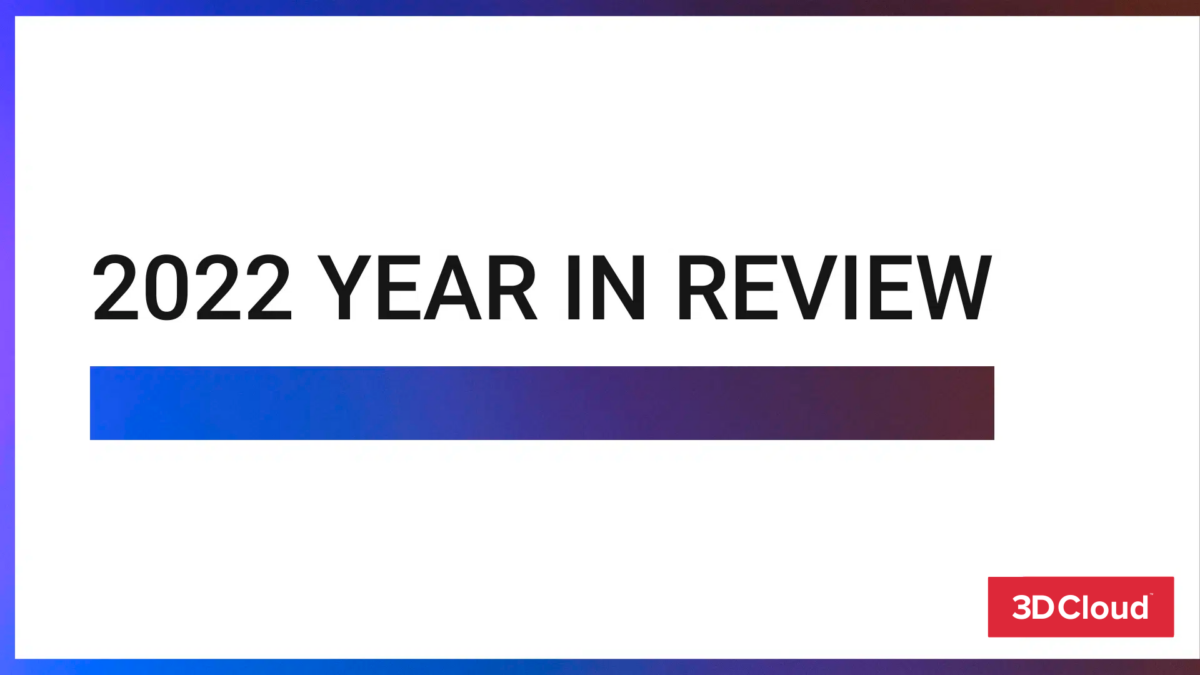
2022 has been an interesting year for 3D commerce. We have rounded up our top 3 things that happened in 2022 as well as offering what we predict we will see emerging in 2023. Keep reading to see our thoughts.
2022 YEAR IN REVIEW
1. Platform Before Apps: For larger retailers and manufacturers, investing in apps has become secondary to investing in their 3D content management platform. 3D platform decisions have become a multi-stakeholder evaluation involving merchandising, marketing, digital, IT, configurator owners, and enterprise architecture teams. Here’s a link to a video case study from MillerKnoll that brings this trend to life.
2. 3D for Cost Savings & Virtual Design: While in prior years investments in 3D targeted new ways to engage shoppers to increase share and engagement, the focus in 2022 was on using 3D to reduce operating costs. Two of the largest areas of investment were in virtual design teams and self-service solutions. We saw several retailers increase the size of their virtual design teams from double to triple digits as they reduced store staff. Additionally, many retailers leveraged 3D applications to enable homeowners to matriculate through more of the sales cycle on their own. The goal here is to further qualify prospects and deliver higher quality leads to design teams that are more likely to convert. For instance, design leads from self-service planning tools are ten times more likely to convert than leads from forms or surveys. Here is a link to a video featuring B&Q’s 3D Kitchen Designer which aims to serve homeowners, pros, designers, and store associates.
3. Augmented Reality 2.0: AR is now a mainstay for home goods retailers and an expectation of a growing number of consumers. We’ve learned that the principle use case for AR is as a replacement for a measuring tape as consumers use the tech to check for fit. It makes sense then that we see that the most popular products viewed in AR are larger items such as couches, sectionals, dining room sets, and bedroom furniture. Retailers investing in AR, as expected, are getting more intentional about what products are 3D modeled. However, we’re hearing a number of retailers asking about what “AR 2.0” will look like. The ability to place multiple items in a room is a more frequent request. We’re also fielding interest in AR features that will enable users to save and collect their favorite products in AR rather than having to navigate back to a specific product page. We’ve heard these requests and we’re working on a novel solution to make AR a more fulsome experience which will be launching in Q1 2023. Here’s a sneak peek.
PREDICTIONS FOR 2023
1. Room Scanning & Automation:Apple launched a new feature that enables homeowners to use their iPhone to capture their floor plan (available to iOS 16 and above). Many retailers and brands are excited to see this tech as it has the potential to reduce measuring errors and enable homeowners to self-serve. Right alongside room scanning, we’re anticipating a growing demand for design automation tech as companies envision further enabling users to self-serve through more of the purchase cycle. We’ve made significant investments for the kitchen category in both room scanning and automation and plan to extend this tech to furniture, office, bathrooms, and outdoor categories in the months to come. Here is a video of room scanning and automation tech in action.
2. Mobile Planning: Upwards of 60% of retail e-commerce is now mobile, and it’s growing. Traditional 3D planning applications offer only desktop experiences as they aim to serve design teams. As self-service for planning apps grows among homeowners, it follows that there is a growing demand for mobile experiences. As you’d imagine, drawing a floor plan and building out a room as complex as a kitchen on a mobile device will have its challenges. However, room scanning and automation tech may be the solution that kills two birds with a single stone. Here’s a video of how we imagine the future of room design on mobile.
3. Distribution of Content Costs & Visual Merchandising: If you’re a retailer and you invested in 3D already, you’ve yearned for the day when manufacturers would be able to contribute 3D models to support your efforts. While this is happening between retailers and manufacturers to some degree today, the practice is not widespread. Our experience has been that unless a manufacturer has a highly configurable product catalog and is investing in 3D for their own purposes, the motivation to invest in 3D assets that may be shared with retailers is not meaningful. This, however, is starting to change as we see manufacturers investing in 3D as a way to engage retailer merchants in the buying process. Moreover, manufacturers are evaluating 3D room planning applications as a faster and less expensive way to create custom virtual merchandising for retail partners. Web-based 3D rendering technologies have advanced considerably over the past few years making it possible for non 3D artists to create high quality content quickly and easily. Here are some fun examples from our HD Renderings Gallery.
Do you agree with our predictions? If you are interested in learning more about 3D Cloud®, feel free to contact us. We are happy to be of service to you and your teams as you develop your 3D commerce program.











